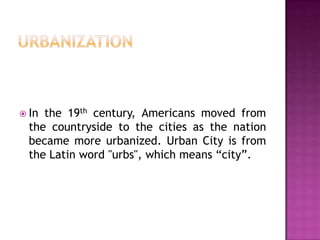
American society
- 1. In the 19th century, Americans moved from the countryside to the cities as the nation became more urbanized. Urban City is from the Latin word "urbs", which means “city”.
- 2. The quantitative study of human populations in order to identify the influences on population growth and structure.
- 3. A small building found in New York City, especially in New York’s Lower East Side. Tenements are usually no more than five stories high, with narrow staircases and tiny apartments. Tenements were home to many European immigrants during the 19th century. Unsafe conditions, especially overcrowding in the tenements caused a lot of sickness and death among immigrants, and in 1863, new "tenement laws" were passes stating things like, all apartments must have windows.
- 4. A political machine is a corrupt political organization in which an authoritative boss or small group commands the support of a corps of supporters and businesses (usually campaign workers), who receive rewards for their efforts. The machine's power is based on the ability of the workers to get out the vote for their candidates on Election Day.
- 5. Leaders of Political Machines
- 6. Immigration is the movement of people into another country or region to which they are not native in order to settle there.
- 7. Push and pull factors are terms often used for migration. Push factors are factors or causes with which people tend to be pushed away or repelled from certain locations; while pull factors are those conditions that attract people to a particular location. These factors may be due to economic, environmental, religious and even political conditions present in the concerned locations.
- 8. Came from southern and eastern Europe, especially Poland, Italy, AustriaHungary, Greece, and Russia. They were often catholic, Jewish, or orthodox Christian rather than Protestant, and spoke no English.
- 9. A group of people of the same ethnicity living together in the same area of a city. Generally smaller areas usually crowded and in poor conditions.
- 10. Nativism typically means opposition to immigration and support of efforts to lower the political or legal status of specific ethnic or cultural groups because the groups are considered hostile or alien to the natural culture, and assumptions that they cannot be assimilated.
- 11. Americanization or Americanisation is a term for the influence the United States has on the culture of other countries, such as their popular culture, cuisine, technology, business practices, or political techniques.
- 12. Prohibits all immigration of Chinese laborers.
- 13. The political and geographical areas near or beyond a boundary.
- 14. A broad expanse of flat land, much of it covered in prairie, steppe and grassland, which lies west of the River and east of the Rocky Mountains in the United States and Canada. This area covers parts of the U.S. states of Colorado, Kansas, Montana, Nebraska, New Mexico, North Dakota, Oklahoma, South Dakota, Texas, and Wyoming, and the Canadian provinces of Alberta, Manitoba and Saskatchewan.
- 15. A migration by an estimated 100,000 prospectors to the Klondike region of the Yukon in northwestern Canada, (1896 - 1899). Gold was discovered here on August 16, 1896 and, when news reached Seattle and San Francisco the following year, it triggered a "stampede" of would-be prospectors. The journey proved too hard to many and only between 30,000 and 40,000 managed to arrive. Some became wealthy, but the majority went in vain and only around 4,000 struck gold. The Klondike Gold Rush ended in 1899 after gold was discovered in Nome, prompting an exodus from the Klondike. It has been immortalized by photographs, books and films.
- 16. United States federal laws that gave an applicant ownership of land, typically called a "homestead", at little or no cost.
- 17. The name used in the United States to describe the multiple conflicts between American settlers or the federal government and the native peoples of North America from the time of earliest colonial settlement until approximately 1890.
- 18. An area of land managed by a Native American tribe under the United States Department of the Interior's Bureau of Indian Affairs.
- 19. Adopted by Congress in 1887, authorized the President of the United States to survey American Indian tribal land and divide it into allotments for individual Indians.
- 20. Also known as the Snyder Act, was proposed by Representative Homer P. Snyder (R) of New York and granted full U.S. citizenship to America's indigenous peoples, called "Indians" in this Act.
